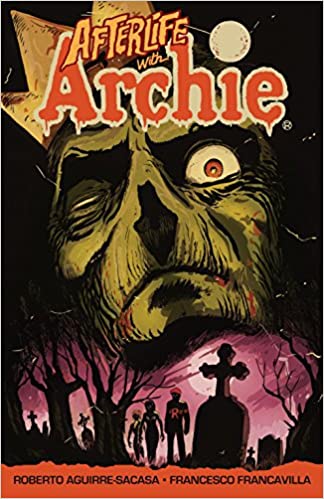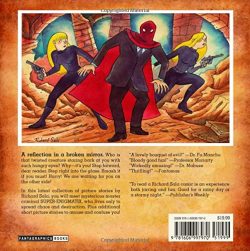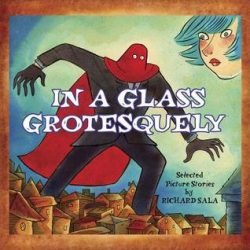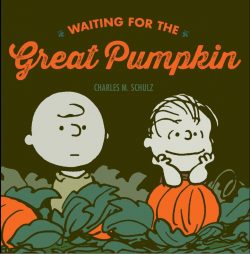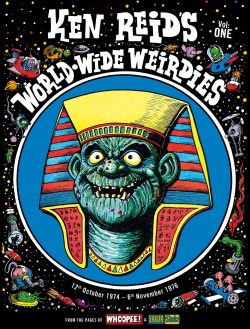
By illustrated by Graham Ingels, written by Al Feldstein with Ray Bradbury & Bill Gaines (Fantagraphics Books)
ISBN: 978-1-60699-689-8 (HB)
For most people who have heard of them, EC Comics mean one thing only: shocking, appalling, stomach-turning horror. Moreover, the artist they’re probably picturing – even if they can’t name him – is Graham Ingels, who wryly sighed his work “Ghastlyâ€â€¦
The company began in 1944 when comicbook pioneer Max Gaines – presumably seeing the writing on the wall – sold the superhero properties of his All-American Comics company to half-sister National/DC, retaining only Picture Stories from the Bible. His plan was to produce a line of Educational Comics with schools and church groups as the major target market.
He augmented his flagship title with Picture Stories from American History, Picture Stories from Science and Picture Stories from World History but the worthy projects were all struggling when he died in a boating accident in 1947.
As detailed in the comprehensive closing essay of this superb graphic compilation (‘Crime, Horror, Terror, Gore, Depravity, Disrespect for Established Authority – and Science Fiction Too: the Ups and Downs of EC Comics’ by author, editor, critic and comics fan Ted White), his son William was dragged into the company by unsung hero and Business Manager Sol Cohen who held the company together until the initially unwilling Bill Gaines abandoned his dreams of being a chemistry teacher and transformed the ailing Educational enterprise into Entertaining Comics…
After a few tentative false starts and abortive experiments copying industry fashions, Gaines took advantage of his multi-talented associate Al Feldstein, who promptly graduated from creating teen comedies and westerns into becoming Gaines’ editorial supervisor and co-conspirator.
As they began co-plotting the bulk of EC’s stories together, they changed tack, moving in a boldly impressive fresh direction. Their publishing strategy, wisely utilising the most gifted illustrators in the field, was to tell a “New Trend†of stories aimed at older and more discerning readers, not the mythical semi-literate 8-year-old all comicbooks ostensibly targeted.
From 1950 to 1954 EC was the most innovative and influential publisher in America, dominating the genres of crime, horror, war and science fiction and originating an entirely new beast: the satirical comicbook…
Feldstein had started life as a comedy cartoonist and, after creator/editor Harvey Kurtzman departed in 1956, Al became Mad‘s Editor for the next three decades…
This seventh volume of the Fantagraphics EC Library gathers a mind-boggling selection of Feldstein’s most baroque and grotesquely hilarious horror stories – most co-plotted by companion-in-crime Gaines – and all illuminated by the company’s enigmatic yet unsurpassed master of macabre mood, in a lavish monochrome hardcover or digital edition packed with supplementary interviews, features and dissertations.
It begins with historian and lecturer Bill Mason’s touching and revelatory commentary ‘Mr. Horror Builds his Scream House’ before dipping into this diary of disgust and dread with ‘Hook, Line, and Stinker!’ (Vault of Horror #26, August/September 1952): the tale of a spinster’s vengeance after she finds the gentleman she’s been affianced to for fifteen years spends his weekends in the arms of a young floozy rather than on his precious – and fictitious – fishing trips…
The most memorable assets of EC’s horror titles were the uniquely memorable hosts whose execrable wisecracks bracketed each fantastic yarn. The Vault-Keeper, Crypt-Keeper and Old Witch were the company’s only returning characters during the New Trend era, becoming beloved favourites of the “Fan Addict†readership. Haunt of Fear #14 (July/August 1952) revealed the shocking and hilarious origins of the scurvy sorceress herself in a sublime pastiche of the Christian Nativity dubbed ‘A Little Stranger!’…
A murderous elephant trainer’s infidelities come back to haunt him in circus chiller ‘Squash… Anyone?’ (Tales From the Crypt #32, October/November 1952), whilst in that same month, in Vault of Horror #27, a rat-infested kingdom where starving peasants are tormented by their over-stuffed queen provide grisly meat for ‘A Grim Fairy Tale!’
‘Chatter-Boxed!’ (Haunt of Fear #15, September/October 1952) is a superb blend of maguffins as a man terrified of premature burial takes special steps to ensure he’s never buried alive, but even after factoring in that his wife is always gabbing on the phone, there’s one element he could never have foreseen…
Next follows a wealth of material published in titles cover-dated December 1952/January 1953, beginning with ‘Private Performance’ from Crime SuspenStories #14, wherein a burglar witnesses a murder in an old Vaudevillian’s home before hiding in exactly the wrong place, whilst ‘None but the Lonely Heart!’ (Tales from the Crypt #33) reveals the ultimate downfall of a serial bigamist and black widower.
‘We Ain’t Got No Body’ (Vault of Horror #28), ghoulishly revels in the vengeance of a man murdered by fellow train commuters before ‘Sugar ‘n Spice ‘n…’ (Shock SuspenStories #6) toys wickedly with the fable of Hansel and Gretel, proving some kids get what they deserve…
A pioneering surgeon is blackmailed for decades by his greatest triumph in ‘Nobody There!’ (Haunt of Fear #16, November/December 1952), whilst ‘Hail and Heart-y!’ (from Crime SuspenStories #15 February/March 1953) sees a lazy husband driving his enduring wife to exhaustion and over the edge by feigning disability, before Ingels superbly captures the macabre eccentricity of Ray Bradbury’s story of a crusty dowager too mean to stay decently dead in ‘There Was an Old Woman!’ – from Tales from the Crypt #34 (February/March).
That same month Vault of Horror #29 featured ‘Pickled Pints!’, as unscrupulous rogues buying cut-rate blood from winos push their plastered pumps a little too far, after which Haunt of Fear #17 (January/February) offers the acme of sinister swamp scare stories in ‘Horror We? How’s Bayou?’: a tale of rural madness and supernatural revenge long acclaimed as the greatest EC horror story ever crafted…
An irritated and merciless mummy stalks an Egyptian dig in ‘This Wraps it Up!’ (Tales from the Crypt #35, April/May 1953; the same month Vault of Horror #30 told a truly chilling tale of human retribution when the good citizens of a small town finally find the writer of cruel poison-pen letters in ‘Notes to You!’, after which ‘Pipe Down!’ (Haunt of Fear#18, March/April) goes completely round the bend to describe how a young wife and handsome plumber get rid of her rich old man… and what the victim does about it…
Bradbury’s disturbing yarn ‘The Handler’ was adroitly adapted in Tales from the Crypt #36 (June/July) depicting how an undertaker’s secret liberties – inflicted upon the cadavers in his care – came back to haunt him, whilst over in Vault of Horror #31 that month ‘One Good Turn…’ revealed one little old lady’s gruesome interpretation of the old adage, and Haunt of Fear #19 (May/June 1953) discloses the incredible lengths some men will go to in order to kill vampires in eponymous shocker ‘Sucker Bait!’…
From August/September, ‘The Rover Boys’ in Tales from the Crypt #37 is a purely bonkers tale of brain transplantation gone wild, whilst Vault of Horror #32 offers up more traditional fare with ‘Funereal Disease!’, describing how a murdered miser gets back what he loves most, and ‘Thump Fun!’ (Haunt of Fear #20, July/August) archly revisits Poe’s Tell-Tale Heart whilst adding a little twist…
‘Mournin’ Mess’ (Tales from the Crypt #38, October/November) is a stylish and clever mystery about rich men funding a paupers graveyard – and why – whilst over in Vault of Horror (#32) ‘Strung Along’ depicts the revenge marionettes inflicted on the greedy woman who murdered their elderly puppeteer before the artistic arcana all ends with ‘An Off-Color Heir’ (Haunt of Fear #21, September/October 1953) and the salutary tale of an artist’s wife who discovers just too late her man’s habits and horrific heritage …
Adding final weight to the proceedings is S.C. Ringgenberg’s biography of the tragic genius ‘Graham Ingels’, the aforementioned history of EC and a comprehensively illuminating ‘Behind the Panels: Creator Biographies’ feature by Mason, Spurgeon and Janice Lee.
The short, sweet but severely limited output of EC has been reprinted ad infinitum in the decades since the company died. These astounding stories and art not only changed comics but also infected the larger world through film and television and via the millions of dedicated devotees still addicted to New Trend tales.
However, the most influential stories are somehow the ones least known these days. Although Ingels turned his back on his comics career, ashamed of the furore and frenzy generated by closed-minded bigots in the 1950s, his incredible artistic talent and narrative legacy are finally gaining him the celebrity he should have had in life.
Sucker Bait is a scarily lovely tribute to the sheer ability of an unsung master of comics art and offers a fabulously engaging introduction for every lucky fear fan encountering the material for the very first time. Whether you are an aging fear aficionado or callow contemporary convert, this is a book you should have…
Sucker Bait and Other Stories © 2014 Fantagraphics Books, Inc. All comics stories © 2014 William M. Gaines Agent, Inc., reprinted with permission. All other material © 2014 the respective creators and owners.





